|
|
Advertisement:
|
|
Intel Penryn: Fast, cool, and “greenish” |
|
Join the community - in the OCAU Forums!
|
Benchmarking Setup, Sandra, Gaming
How We Tested:
Today we are mainly benchmarking the QX9650 against its predecessor, the QX6850. Both CPUs are running with the same clock speed of 3000 MHz. Any difference between them can therefore be attributed to Penryn’s enhanced micro-architecture and the 45nm transistor shrinkage. However, due its affordability the Q6600 is currently the most popular quadcore CPU. We include this CPU as well, as we assume that the many Q6600 owners want to know how their quadcore CPU compares with the new arrival. For good measure we include 2 dual core CPUs as well. The first one is Intel’s E6850. It runs at the same clock speed of 3000 MHz, like the quadcore QX9560 and QX6850 and therefore makes for an interesting comparison. Finally we included AMD’s currently fastest desktop product, the dual core X2 6400+. Yes, we know, it’s somehow unfair to compare a just launched new processor with a product that is based on a four year old micro-architecture. But it was not possible to source a sample of AMD’s upcoming K10 based “Phenom” family. All Intel CPUs were tested on the same platform: The Intel P35 chipset based Asus P5K Deluxe and DDR2. We used Windows Vista Ultimate 32-bit with the latest updates installed. The X2 6400+ was tested with another Asus motherboard, the M2N32-SLI. Identical RAM and peripherals were used for both test platforms.
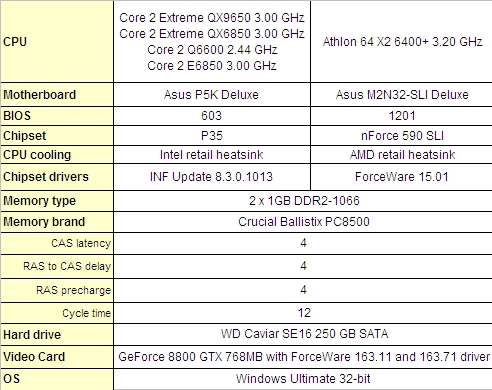
We benchmarked the 5 processors in 6 test rounds comprising similar applications. And after that of course, we will present the “fruits” of our overclocking attempts.
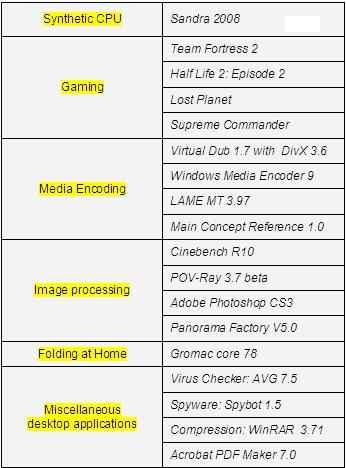
Synthetic Benchmarks with Sandra XIIc:
Our first test round was performed with SiSoftware's Sandra XIIc, the “System ANalyser, Diagnostic and Reporting Assistant”. Sandra’s CPU, Multimedia and Memory benchmarks should give us a general idea of the impact of Penryn’s 50% bigger L2 cache and enhanced micro-architecture.
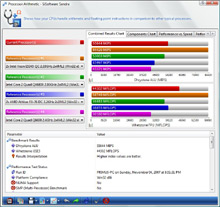 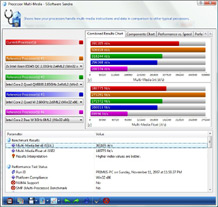 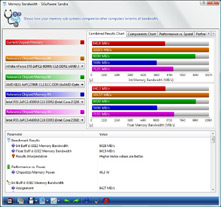
Sandra Arithmetic, Multimedia and Bandwidth

The CPU arithmetic benchmark shows the QX9650 leading the QX6850 by around 3%. The floating point benchmark however shows the QX9650 with a lead of 15%. Obviously this is the impact of the fast radix-16 divider unit. The multimedia CPU floating point benchmark has both CPU performing head-to-head. The multimedia integer test takes advantage of the new SSE4.1 instructions and unsurprisingly we see the QX9650 with a substantial gain of 20% in this test. Memory bandwidth improves by around 5% with the QX9650, but is still far behind the X2 6400+ system. AMD’s on-die memory controller still plays in a league of its own when it comes to memory bandwidth.
Gaming:
We selected four popular 3D games for this gaming test round: Team Fortress 2, Half Life 2 Episode 2, Lost Planet and Supreme Commander. In previous reviews we have tested only with a resolution of 1024x768. Such relative low resolution is preventing the video card from becoming the performance limiter and shows therefore the impact of the CPU. However, some readers complained this to be an unrealistically low resolution. We therefore ran the gaming benchmarks at 1920x1200 as well. In all tests detail level and image quality were set to their highest settings and anti-aliasing disabled.
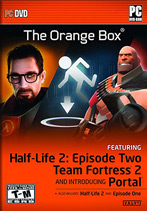  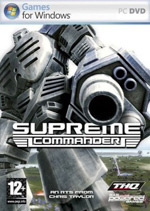
Team Fortress 2 is a first person shooter game based on the “Source” game engine and DirectX9. We recorded a short game session and played it back using the built-in time-demo function. At 1024x768 we can see the QX9850 providing around 10% more frames per second than the QX6850. At 1920x1200 the difference goes down to 5%. We can also see that the differences between quadcore and dual core CPU are relatively small in this game. We checked out CPU utilization with Vista’s “Task Manager” and found indeed that TF2 is utilizing mainly only 1 core.
Half Life 2: Episode 2 is a hugely popular first shooter game based on the “Source” game engine. We created a demo run and then played it back using the “timedemo mydemoname” command. The results shown are the average frame rates reported back to the console. At 1024x768 the QX9650 provides around 10 frames per second more than the QX6859. This is a gain of around 7%. At 1920x1200 there is again basically no difference noticeable between Yorkfield and Kentsfield.
Lost Planet: Extreme Condition is DirectX10 based and runs multithreaded. We enabled the game’s multi-core function for our test. The game has several built-in benchmarks; we are showing the results for “Cave”. This is the most demanding level, because it throws a high load of flying doo-dads and other details at the gamer making best use of the game’s multithreading capabilities. At 1024x768 the QX9650 system is 10% faster than the QX6850. The results show also that a quadcore CPU is clearly of advantage in this game when playing at lower resolutions. Nonetheless, at 1920x1200 the difference between the tested CPU becomes largely negligible. At such high resolution frame performance is almost entirely driven by the graphics card.
Supreme Commander is a DirectX 9 based strategy game. We used the built-in FPS benchmark. Although the QX9650 comes out first, the distance to the QX6850 is just 3%, and of course not actually noticeable when playing the game. Even at the low resolution of 1024x768 the difference between the fastest and the slowest CPU is just 12%. Also the number of cores seems to have no influence on performance. At 1920x1200 the already small difference between the CPUs became zero and the QX9650 system performs no better than the otherwise slowest CPU, the X2 6400+.
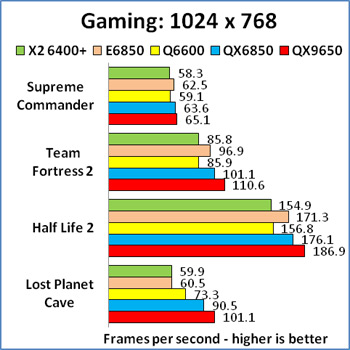 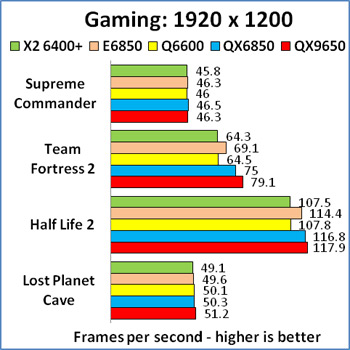
|
|
Advertisement:
All original content copyright James Rolfe.
All rights reserved. No reproduction allowed without written permission.
Interested in advertising on OCAU? Contact us for info.
|

|


